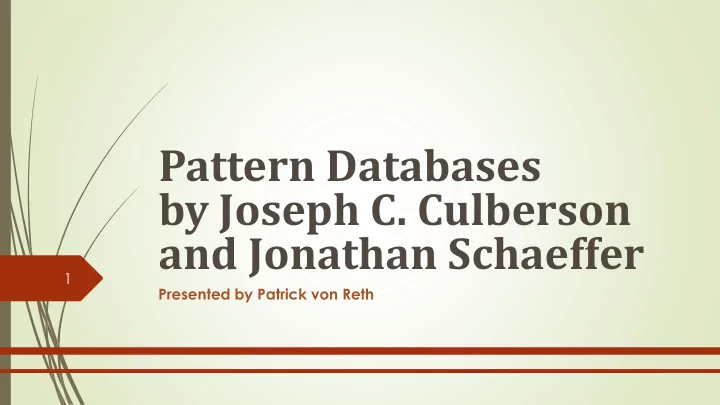

Pattern Databases by Joseph C. Culberson and Jonathan Schaeffer 1 Presented by Patrick von Reth
The 15-Puzzle 2 15-Puzzle is a permutation problem. Problems where a set of operators converts one permutation into another Reach goal permutation with as few operators as possible Another prominent example is the Rubik’s Cube.
The 15-Puzzle 3 1 5 6 3 0 1 2 3 4 5 6 7 12 9 4 2 15 11 10 7 8 9 10 11 12 13 14 15 13 14 0 8
Manhattan Distance 4 Distance between two positions in a grid Sum of the vertical and horizontal distance Example: Distance for the empty tile to its goal position. Manhattan heuristic: Sum of distances for all tiles to their goal position. 1 5 2 3 4 9 6 7 8 10 11 0 12 13 14 15
Linear conflict heuristic 5 Extension of the Manhattan heuristic. If two tiles are in linear conflict they have to surround each other. Increase the heuristic by two. Example: The Manhattan distance for tile 4 and for tile 7 is two. 0 1 2 3 5 7 4 6 8 9 10 11 12 13 14 15
Pattern databases 6 Human-like approach to solve a complex permutation problems: Find a partial solution and thus reduce the complexity of the problem. Find an optimal path to a partial solution Distance to the partial solution is a lower bound for the complete solution. Precompute the distance to the partial solution, for all permutations, and store it in a database.
Fringe and Corner pattern 7 The Corner pattern The Fringe pattern 0 0 3 7 8 9 10 11 12 13 14 15 12 13 14 15
Upper bounds 8 Used to eliminate the last iteration of the IDA* search. Upper bound for the 15-Puzzle For the fringe pattern the upper bound is 61 moves. For the remaining 8-Puzzle the upper bound is 31 moves. This results in an upper limit of 92 moves to completely solve the 15-Puzzle. Different patterns result in different upper bounds.
Solution Databases 9 If obtaining the optimal solution path is to expensive. Precompute optimal solution for sub-goals together with the moves.
Symmetry 10 Can be used to simplify the search tree. For example reflections can be used to obtain additional cost bounds. The maximum of all lower bounds retrieved is then used. Two diagonal reflections , (0,15) and (12,3). The vertical and the horizontal reflection.
Symmetry - Reflections 11 Applying the diagonal reflection (0,15) on a path yields the mirrored path. Can be achieved by remapping the operators d->r, r->d, l->u, u->l Used to retrieve the cost for the reflected state. With some modifications this can also be done for the other reflections.
Symmetry - Cost retrieved using 12 reflections Goal state and its horizontal mirror. Distance of the two state is three. Distance of three is used as penalty on the retrieved cost for the mirror state. 0 1 2 3 1 2 3 0 4 5 6 7 4 5 6 7 8 9 10 11 8 9 10 11 12 13 14 15 12 13 14 15
Symmetry – Reflection penalties 13 Cost for diagonal reflection (0,15) and its mirrored state are the same. Penalty for the horizontal and the vertical reflection is 3. Penalty for the diagonal (12,3) reflection is 6.
Combination of patterns 14 Both pattern databases are used for the heuristic calculation. Using maximum over both databases would be expensive (memory) Split up in 16 databases each. F C F C Lookup defined by empty tile and its mirrors. Only one half of each database is loaded. C F C F F C F C C F C F
Linear conflict heuristic compared to 15 pure Manhattan distance heuristic Presented results are based on the Manhattan distance. Linear conflict heuristic: Search tree size is reduced noticeable. Pattern database with linear conflict heuristic: Only minor improvement.
Results (1) 16 Combination of both pattern databases is better than individual improvements. Many enhancements possible Don’t use the diagonal (12,3) because of the penalty of 6. Don’t lookup every possible reflection.
Results (2) 17 Without those improvements: 12 times faster than a naïve implementation only using the Manhattan distance. 1.5 times faster than using the linear conflict heuristic
Conclusion 18 Computational workload increased. Computation is done before the actual search. Computation is done once, cost will amortise over time. Speedup of 12 and reduction of the search tree size by 1038-fold is impressive. Pattern databases are better than the linear conflict heuristic. Adaptable for different problems.
Questions ? 19
Recommend
More recommend